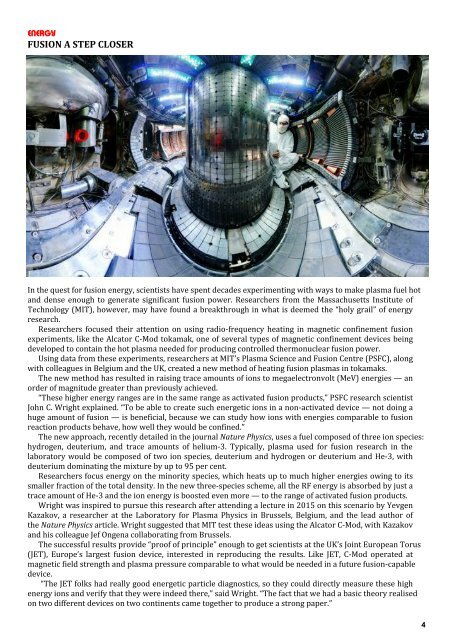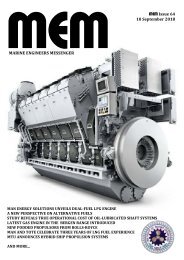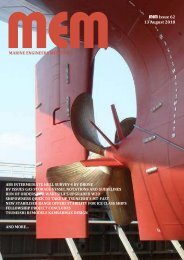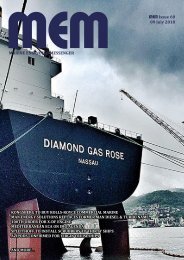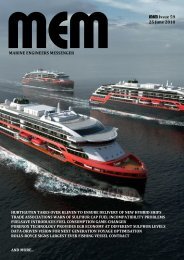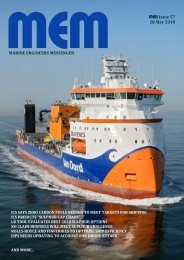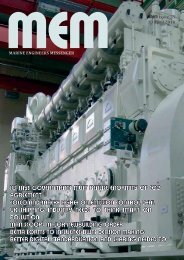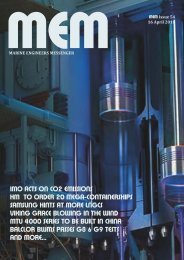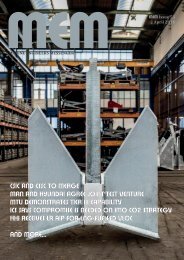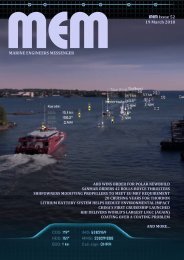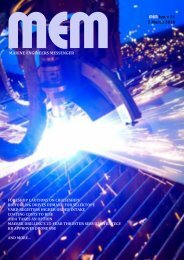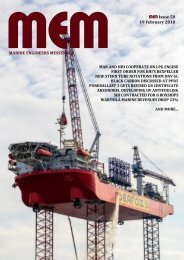MEM38
Marine Engineers Messenger Volume 2 Issue 38
Marine Engineers Messenger Volume 2 Issue 38
You also want an ePaper? Increase the reach of your titles
YUMPU automatically turns print PDFs into web optimized ePapers that Google loves.
ENERGY<br />
FUSION A STEP CLOSER<br />
In the quest for fusion energy, scientists have spent decades experimenting with ways to make plasma fuel hot<br />
and dense enough to generate significant fusion power. Researchers from the Massachusetts Institute of<br />
Technology (MIT), however, may have found a breakthrough in what is deemed the “holy grail” of energy<br />
research.<br />
Researchers focused their attention on using radio-frequency heating in magnetic confinement fusion<br />
experiments, like the Alcator C-Mod tokamak, one of several types of magnetic confinement devices being<br />
developed to contain the hot plasma needed for producing controlled thermonuclear fusion power.<br />
Using data from these experiments, researchers at MIT’s Plasma Science and Fusion Centre (PSFC), along<br />
with colleagues in Belgium and the UK, created a new method of heating fusion plasmas in tokamaks.<br />
The new method has resulted in raising trace amounts of ions to megaelectronvolt (MeV) energies — an<br />
order of magnitude greater than previously achieved.<br />
“These higher energy ranges are in the same range as activated fusion products,” PSFC research scientist<br />
John C. Wright explained. “To be able to create such energetic ions in a non-activated device — not doing a<br />
huge amount of fusion — is beneficial, because we can study how ions with energies comparable to fusion<br />
reaction products behave, how well they would be confined.”<br />
The new approach, recently detailed in the journal Nature Physics, uses a fuel composed of three ion species:<br />
hydrogen, deuterium, and trace amounts of helium-3. Typically, plasma used for fusion research in the<br />
laboratory would be composed of two ion species, deuterium and hydrogen or deuterium and He-3, with<br />
deuterium dominating the mixture by up to 95 per cent.<br />
Researchers focus energy on the minority species, which heats up to much higher energies owing to its<br />
smaller fraction of the total density. In the new three-species scheme, all the RF energy is absorbed by just a<br />
trace amount of He-3 and the ion energy is boosted even more — to the range of activated fusion products.<br />
Wright was inspired to pursue this research after attending a lecture in 2015 on this scenario by Yevgen<br />
Kazakov, a researcher at the Laboratory for Plasma Physics in Brussels, Belgium, and the lead author of<br />
the Nature Physics article. Wright suggested that MIT test these ideas using the Alcator C-Mod, with Kazakov<br />
and his colleague Jef Ongena collaborating from Brussels.<br />
The successful results provide “proof of principle” enough to get scientists at the UK’s Joint European Torus<br />
(JET), Europe’s largest fusion device, interested in reproducing the results. Like JET, C-Mod operated at<br />
magnetic field strength and plasma pressure comparable to what would be needed in a future fusion-capable<br />
device.<br />
“The JET folks had really good energetic particle diagnostics, so they could directly measure these high<br />
energy ions and verify that they were indeed there,” said Wright. “The fact that we had a basic theory realised<br />
on two different devices on two continents came together to produce a strong paper.”<br />
4


